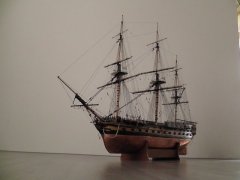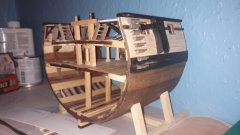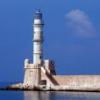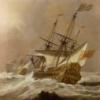-
Posts
2,245 -
Joined
-
Last visited
Reputation Activity
-
 Beef Wellington got a reaction from Sjors in HMS Jason by Beef Wellington - Caldercraft - 1:64 - Artois-class frigate modified from HMS Diana 1794
Beef Wellington got a reaction from Sjors in HMS Jason by Beef Wellington - Caldercraft - 1:64 - Artois-class frigate modified from HMS Diana 1794
Thanks everyone, need to record a few things before moving on too much further:
Tackles:
Boy, these blighters take time. I will definitely not be fully rigging each gun, but will look to rig those fall into possibly the 'noticeable in the background' category. Here's the method I found works best for me. Apologies for the photos, an iPhone is really not the best at trying to photograph tiny objects suspended in the air.
A hook was threaded with 0.3mm Syren line and some overhand knots tied to seize this securely. Drop of GS Hypo cement to keep secure before trimming excess. The long ends are then placed around the block and loose overhand knot tied.
A length of line for the tackle fall is then inserted into the loop and then threaded back through itself as for a false splice.
Pulling the overhand know tight around the block, and simultaneously tightening the false splice secures the knot around the block. Another small drop of GS Hypo cement on the false splice helps keep this secure, and placing the end of the stropping line into 'helping hands' helps keep the knot tight while the cement dries.
Slightly weighting the tackle fall line (in this case with tweezers) allows the alignment if the block to be tweaked before the cement sets fully. Thin thread can then be seized around the splice to secure it, I find alternating overhand knots gives a pretty secure and easy result. Once more, another drop of GS Hypo on the seizing helps ensure this doesn't unravel once trimmed.
Once completed, I use some dilute PVA glue on the stropping prior to trimming off any excess as some additional insurance as it is a frustrating experience for these to break when frapping. The tackle falls were then fed through the previously stropped double blocks, and then frapped on the service machine as per a previous post. The last turn was secured simply by feeding back through the prior turn and pulling taught. The completed tackle can then be placed where needed and some dilute PVA applied again to the whole tackle - special attention was paid to ensuring the tackle fed through the frapping was secured with glue. The entire tackle can then be removed once dry and the excess line trimmed. Its a simple matter to hook these back into position. Et voila!
Stove:
The stove has also been given a little more TLC and is now glued into position. Handles for the boilers were added, as well as rails which were made from brass rod. The rails were the treated with some JAX 'Brown' to darken it a little a keep it in keeping with the colour of the copper still. As described in a previous post, I've followed TFFM simulating wooden battens under the custom base plate rather than simulating tiles, they would not been seen in any event once the main riding bitts are in place. Temporarily putting the fo'c'sl deck in place shows that much of this will be obscured even if the various gratings are made removeable which I plan to do.
In closing, a quick summary of the 3D printed stove. With a little work I'm happy with the way this turned out. Comparison to the kit supplied version shows the dimensions to be a little more authentic, and the detailing is much more pleasing than the approximations on the supplied white metal parts. To be fair, no work was done to pretty this up, but I'd certainly recommend this as a simple 'upgrade'.
-
 Beef Wellington got a reaction from JayCub in HMS Snake by Beef Wellington - FINISHED - Caldercraft - Scale 1: 64 - First wooden ship build
Beef Wellington got a reaction from JayCub in HMS Snake by Beef Wellington - FINISHED - Caldercraft - Scale 1: 64 - First wooden ship build
Cheers Jim and the likes, and thanks Mort - unfortunately I'm way beyond that decision but something to think about for the future...
Rigging seems to be a little bit of a neglected area on this site, so wanted to post few pics of progress, for things specific to this kit where may be of help to others and also to hopefully capture where I've deviated from the plans. Petersson has been INVALUABLE!
As a side note, I also nearly had a heart attack when I brought Snake outside for a few photos - I normally work in artificial light in my basement, and the natural light made all sorts of sorts of previously unseen 'fuzzies' VERY apparent. I vow never to use kit supplied line again, but am committed to making it work here for consistency. Will probably try brushing on some dilute PVA to try to tame them at some point.
I've found the following 3 scenarios to be common:
Plans are not clear - in these cases I've tried to follow Petersson Plans are clear enough and are somewhat consistent with Petersson - in these cases I've followed the plans but tweaked in some cases where it seems to make more sense Plans are clear enough, but differ from Petersson - in these cases I've followed the plans, unless Petersson seems more logical/elegant.
Foreyard and Fore Topmast
Fore yard prior to installation. Jeers and slings also pre-rigged
Foremast installed. I used thicker line on the jeers (.75mm) as this seemed more in keeping with pictures I've found and attached round the yard following Petersson. As expected, I found lashing the slings rather challenging.
I found the trusses could be made following plans and Petersson, but was the devil trying to get in place with all pendants and catharpins. Truss in place (sorry picture is little blurry), I did not even attempt to put in the knave line!
Fore-topmast in place. Found the parrals very fiddly to do, but they can be done according to Petersson. I gave the parral beads a couple of goes in the drum sander to take off the shine and it gave a very pleasing result.
The fore-topsail yard tie and lifts were taken around the fore-topmast with an eye splice as per Petersson.
Belaying items for the foremast is rather challenging on Snake as the for'd bits are very close to the platform and leaves very little room for maneuver. I also didn't make this any easier by belaying the hawsers around the bits either.
And finally, where things stand currently...I added flemish horses to the fore-topsail which are not identified in the Snake plans, but seem pretty ubiquitous and covered in Lever.
-
 Beef Wellington got a reaction from Blue Ensign in HM Cutter Cheerful 1806 by Blue Ensign - FINISHED - Syren Ship Model Company - 1:48 scale
Beef Wellington got a reaction from Blue Ensign in HM Cutter Cheerful 1806 by Blue Ensign - FINISHED - Syren Ship Model Company - 1:48 scale
Sadly I missed your last steps in real time, but the upside is that it allowed me to indulge in a 'binge' - the effort, skill, craftsmanship results speak for themselves in a beautiful model. Well done indeed, an inspiration as always.
-
 Beef Wellington got a reaction from Old Collingwood in HMS Jason by Beef Wellington - Caldercraft - 1:64 - Artois-class frigate modified from HMS Diana 1794
Beef Wellington got a reaction from Old Collingwood in HMS Jason by Beef Wellington - Caldercraft - 1:64 - Artois-class frigate modified from HMS Diana 1794
Thanks everyone for the continued interest
Pat - all I did was add a few bits of wire, credit goes to the guys that made the 3D print!
Mort - Think I've already decided to leave any boats out of the waist, maybe 1, we'll see. Depends on how well I can build one of those, but I have considered putting some alongside but will also depend on how I'll display her if I ever get there. So many decisions. As for leaving of planking off, I've ruled that out as I think there would need to be other modifications as well to hide the typical kit build method deficiencies before I'd be happy, and I want to avoid getting bogged down.
Christian - the paint is the Admiralty brand Red Ochre offered by Caldercraft, I like to keep it simple to ease touch ups and the colour is pleasing to my eye
Vane - you definitely have me confused with someone else! Everything I know I learned from this great site, and my mind is continually thinking about how to do it better next time. There are definitely things I would do differently if I were starting afresh, but everything is a learning opportunity. There are many modelers here of a much higher standard than me.
Mike - You can credit the Syren blocks and lines there, there are much more pleasant to work with than the usual kit stuff. I do like to identify a repeatable 'system'.
-
 Beef Wellington got a reaction from Edwardkenway in Cruizer-class brig by Timmo - FINISHED - 1:36 scale - RADIO
Beef Wellington got a reaction from Edwardkenway in Cruizer-class brig by Timmo - FINISHED - 1:36 scale - RADIO
Wow, congratulations! You should be justifiably proud of Harrier, couldn't ask for more. Hopefully we'll see Enterprize starting soon.
-
 Beef Wellington got a reaction from mtaylor in Cruizer-class brig by Timmo - FINISHED - 1:36 scale - RADIO
Beef Wellington got a reaction from mtaylor in Cruizer-class brig by Timmo - FINISHED - 1:36 scale - RADIO
Wow, congratulations! You should be justifiably proud of Harrier, couldn't ask for more. Hopefully we'll see Enterprize starting soon.
-
 Beef Wellington got a reaction from KARAVOKIRIS in HMS Jason by Beef Wellington - Caldercraft - 1:64 - Artois-class frigate modified from HMS Diana 1794
Beef Wellington got a reaction from KARAVOKIRIS in HMS Jason by Beef Wellington - Caldercraft - 1:64 - Artois-class frigate modified from HMS Diana 1794
Thanks everyone, need to record a few things before moving on too much further:
Tackles:
Boy, these blighters take time. I will definitely not be fully rigging each gun, but will look to rig those fall into possibly the 'noticeable in the background' category. Here's the method I found works best for me. Apologies for the photos, an iPhone is really not the best at trying to photograph tiny objects suspended in the air.
A hook was threaded with 0.3mm Syren line and some overhand knots tied to seize this securely. Drop of GS Hypo cement to keep secure before trimming excess. The long ends are then placed around the block and loose overhand knot tied.
A length of line for the tackle fall is then inserted into the loop and then threaded back through itself as for a false splice.
Pulling the overhand know tight around the block, and simultaneously tightening the false splice secures the knot around the block. Another small drop of GS Hypo cement on the false splice helps keep this secure, and placing the end of the stropping line into 'helping hands' helps keep the knot tight while the cement dries.
Slightly weighting the tackle fall line (in this case with tweezers) allows the alignment if the block to be tweaked before the cement sets fully. Thin thread can then be seized around the splice to secure it, I find alternating overhand knots gives a pretty secure and easy result. Once more, another drop of GS Hypo on the seizing helps ensure this doesn't unravel once trimmed.
Once completed, I use some dilute PVA glue on the stropping prior to trimming off any excess as some additional insurance as it is a frustrating experience for these to break when frapping. The tackle falls were then fed through the previously stropped double blocks, and then frapped on the service machine as per a previous post. The last turn was secured simply by feeding back through the prior turn and pulling taught. The completed tackle can then be placed where needed and some dilute PVA applied again to the whole tackle - special attention was paid to ensuring the tackle fed through the frapping was secured with glue. The entire tackle can then be removed once dry and the excess line trimmed. Its a simple matter to hook these back into position. Et voila!
Stove:
The stove has also been given a little more TLC and is now glued into position. Handles for the boilers were added, as well as rails which were made from brass rod. The rails were the treated with some JAX 'Brown' to darken it a little a keep it in keeping with the colour of the copper still. As described in a previous post, I've followed TFFM simulating wooden battens under the custom base plate rather than simulating tiles, they would not been seen in any event once the main riding bitts are in place. Temporarily putting the fo'c'sl deck in place shows that much of this will be obscured even if the various gratings are made removeable which I plan to do.
In closing, a quick summary of the 3D printed stove. With a little work I'm happy with the way this turned out. Comparison to the kit supplied version shows the dimensions to be a little more authentic, and the detailing is much more pleasing than the approximations on the supplied white metal parts. To be fair, no work was done to pretty this up, but I'd certainly recommend this as a simple 'upgrade'.
-
 Beef Wellington got a reaction from egkb in Cruizer-class brig by Timmo - FINISHED - 1:36 scale - RADIO
Beef Wellington got a reaction from egkb in Cruizer-class brig by Timmo - FINISHED - 1:36 scale - RADIO
Wow, congratulations! You should be justifiably proud of Harrier, couldn't ask for more. Hopefully we'll see Enterprize starting soon.
-
 Beef Wellington got a reaction from Barbossa in HMS Jason by Beef Wellington - Caldercraft - 1:64 - Artois-class frigate modified from HMS Diana 1794
Beef Wellington got a reaction from Barbossa in HMS Jason by Beef Wellington - Caldercraft - 1:64 - Artois-class frigate modified from HMS Diana 1794
Thanks everyone for the continued interest
Pat - all I did was add a few bits of wire, credit goes to the guys that made the 3D print!
Mort - Think I've already decided to leave any boats out of the waist, maybe 1, we'll see. Depends on how well I can build one of those, but I have considered putting some alongside but will also depend on how I'll display her if I ever get there. So many decisions. As for leaving of planking off, I've ruled that out as I think there would need to be other modifications as well to hide the typical kit build method deficiencies before I'd be happy, and I want to avoid getting bogged down.
Christian - the paint is the Admiralty brand Red Ochre offered by Caldercraft, I like to keep it simple to ease touch ups and the colour is pleasing to my eye
Vane - you definitely have me confused with someone else! Everything I know I learned from this great site, and my mind is continually thinking about how to do it better next time. There are definitely things I would do differently if I were starting afresh, but everything is a learning opportunity. There are many modelers here of a much higher standard than me.
Mike - You can credit the Syren blocks and lines there, there are much more pleasant to work with than the usual kit stuff. I do like to identify a repeatable 'system'.
-
 Beef Wellington got a reaction from egkb in HMS Jason by Beef Wellington - Caldercraft - 1:64 - Artois-class frigate modified from HMS Diana 1794
Beef Wellington got a reaction from egkb in HMS Jason by Beef Wellington - Caldercraft - 1:64 - Artois-class frigate modified from HMS Diana 1794
Thanks everyone for the continued interest
Pat - all I did was add a few bits of wire, credit goes to the guys that made the 3D print!
Mort - Think I've already decided to leave any boats out of the waist, maybe 1, we'll see. Depends on how well I can build one of those, but I have considered putting some alongside but will also depend on how I'll display her if I ever get there. So many decisions. As for leaving of planking off, I've ruled that out as I think there would need to be other modifications as well to hide the typical kit build method deficiencies before I'd be happy, and I want to avoid getting bogged down.
Christian - the paint is the Admiralty brand Red Ochre offered by Caldercraft, I like to keep it simple to ease touch ups and the colour is pleasing to my eye
Vane - you definitely have me confused with someone else! Everything I know I learned from this great site, and my mind is continually thinking about how to do it better next time. There are definitely things I would do differently if I were starting afresh, but everything is a learning opportunity. There are many modelers here of a much higher standard than me.
Mike - You can credit the Syren blocks and lines there, there are much more pleasant to work with than the usual kit stuff. I do like to identify a repeatable 'system'.
-
 Beef Wellington got a reaction from EricWilliamMarshall in Double planking a hull: pros and cons
Beef Wellington got a reaction from EricWilliamMarshall in Double planking a hull: pros and cons
My suggestion, based on personal experience,, would be to start with a double planked hull. That will give you a chance to get a feel for the process (twice in fact!), as understanding how planks need to be shaped comes with the experience of doing. Its possible to plank a hull with any kit supplied strip, but it will not be planked in authentic fashion. If you will be painting and coppering, I would say this is a lesser concern as this will not be very visible. For a beginner (and I put myself in that category as I've only planked 2 hulls), its nice knowing that the shape of the hull can be figured out with a first planking, sanded and filled as necessary to give a really nice surface for the second planking.
Single planking will require more time and expertise in shaping planks (spiling) and also using other techniques, drop planking. Not that I don't think it could be learned as a start, but I would suggest you might reach a point of frustration and stop.
There are some kits available now that seem to provide pre-cut shaped planks out of the box (Master Korabel "Tender Avos" comes to mind) although it is still double planked.
-
 Beef Wellington got a reaction from druxey in Can you identify this feature? 19th century 1st Rates
Beef Wellington got a reaction from druxey in Can you identify this feature? 19th century 1st Rates
Taken from Andrew Lambert's "The last sailing Battlefleet", the Queen class were provisionally designed for 110 guns, all 32lb with the exception of two 68lb cannons on each of the lower and middle gun deck. The total also include two 68lb focsl carronades. While still on the stocks, and based on experience with the launched Queen, three ships were lengthened by 3 feet at the bow to accommodate 118 or 120 guns (including a full lower gun deck of 68lb cannons), but not as a result of steam modification. Marlborough which was the least advanced, was further redesigned to carry 68lb cannon on all decks (!) at launch.
Unfortunately I have no information on any subsequent changes in armament, before or after lengthening to accommodate steam, but clearly that was at some point after initial launching, and born out by the photos above.
Sadly after reviewing every photograph of both pre and post steam ships, I can't see any similar structure to the question that started this thread. My view, they appear more along the line of outboard lights than any sort of armament - why would any further armament addition not use one of the already cut gun ports, makes no sense from an engineering standpoint to cut another port right between 2 perfectly good ones. Just my 2c...
-
 Beef Wellington got a reaction from mtaylor in Double planking a hull: pros and cons
Beef Wellington got a reaction from mtaylor in Double planking a hull: pros and cons
My suggestion, based on personal experience,, would be to start with a double planked hull. That will give you a chance to get a feel for the process (twice in fact!), as understanding how planks need to be shaped comes with the experience of doing. Its possible to plank a hull with any kit supplied strip, but it will not be planked in authentic fashion. If you will be painting and coppering, I would say this is a lesser concern as this will not be very visible. For a beginner (and I put myself in that category as I've only planked 2 hulls), its nice knowing that the shape of the hull can be figured out with a first planking, sanded and filled as necessary to give a really nice surface for the second planking.
Single planking will require more time and expertise in shaping planks (spiling) and also using other techniques, drop planking. Not that I don't think it could be learned as a start, but I would suggest you might reach a point of frustration and stop.
There are some kits available now that seem to provide pre-cut shaped planks out of the box (Master Korabel "Tender Avos" comes to mind) although it is still double planked.
-
 Beef Wellington got a reaction from Timmo in Cruizer-class brig by Timmo - FINISHED - 1:36 scale - RADIO
Beef Wellington got a reaction from Timmo in Cruizer-class brig by Timmo - FINISHED - 1:36 scale - RADIO
Wow, congratulations! You should be justifiably proud of Harrier, couldn't ask for more. Hopefully we'll see Enterprize starting soon.
-
 Beef Wellington got a reaction from robdurant in HMS Jason by Beef Wellington - Caldercraft - 1:64 - Artois-class frigate modified from HMS Diana 1794
Beef Wellington got a reaction from robdurant in HMS Jason by Beef Wellington - Caldercraft - 1:64 - Artois-class frigate modified from HMS Diana 1794
Thanks everyone for the continued interest
Pat - all I did was add a few bits of wire, credit goes to the guys that made the 3D print!
Mort - Think I've already decided to leave any boats out of the waist, maybe 1, we'll see. Depends on how well I can build one of those, but I have considered putting some alongside but will also depend on how I'll display her if I ever get there. So many decisions. As for leaving of planking off, I've ruled that out as I think there would need to be other modifications as well to hide the typical kit build method deficiencies before I'd be happy, and I want to avoid getting bogged down.
Christian - the paint is the Admiralty brand Red Ochre offered by Caldercraft, I like to keep it simple to ease touch ups and the colour is pleasing to my eye
Vane - you definitely have me confused with someone else! Everything I know I learned from this great site, and my mind is continually thinking about how to do it better next time. There are definitely things I would do differently if I were starting afresh, but everything is a learning opportunity. There are many modelers here of a much higher standard than me.
Mike - You can credit the Syren blocks and lines there, there are much more pleasant to work with than the usual kit stuff. I do like to identify a repeatable 'system'.
-
 Beef Wellington reacted to Timmo in Cruizer-class brig by Timmo - FINISHED - 1:36 scale - RADIO
Beef Wellington reacted to Timmo in Cruizer-class brig by Timmo - FINISHED - 1:36 scale - RADIO
Harrier has been sailing for a while now but I've finally got her how I wanted her with some modifications to improve yard rotation and hence windward ability and also the cosmetics like gun and other rigging.
Also, I've got evidence that she sails uploaded to youtube, (check my other vids and you can also see my recently built cedar canoe that's kept me from ship modelling for a bit).
Thanks to all who offered advice and knowledge, whether you knew it or not, and provided actual bits for her. It wouldn't have happened without you.
Harrier cleared for action.
The deck hatches lines offering access to the radio gear disappear at the right angles. You can see the rear hatch to the left in this shot and the clear tape that's used to seal them before sailing. After many attempts to get a self sealing hatch with rubber seals this was far easier and more effective.
The tiller is functional with the lines coming from a drum servo below decks and pulling it to either side. The wheel, however, is static as it felt like one more thing to go wrong and a little fragile. It's nice watching the tiller swing under a ghost helmsman's hand.
Sailing into the sunset. I've got plans scaled for a 1/36 Enterprize class 28-gun frigate and might start on some smaller pieces of that in near future. However, if the bank balance allows this year I'll crack into my real dream of a 1:1 sailing dinghy. Time for the real thing.
Thanks for following this drawn-out build.
-
 Beef Wellington got a reaction from Ronald-V in HMS Jason by Beef Wellington - Caldercraft - 1:64 - Artois-class frigate modified from HMS Diana 1794
Beef Wellington got a reaction from Ronald-V in HMS Jason by Beef Wellington - Caldercraft - 1:64 - Artois-class frigate modified from HMS Diana 1794
Thanks everyone, need to record a few things before moving on too much further:
Tackles:
Boy, these blighters take time. I will definitely not be fully rigging each gun, but will look to rig those fall into possibly the 'noticeable in the background' category. Here's the method I found works best for me. Apologies for the photos, an iPhone is really not the best at trying to photograph tiny objects suspended in the air.
A hook was threaded with 0.3mm Syren line and some overhand knots tied to seize this securely. Drop of GS Hypo cement to keep secure before trimming excess. The long ends are then placed around the block and loose overhand knot tied.
A length of line for the tackle fall is then inserted into the loop and then threaded back through itself as for a false splice.
Pulling the overhand know tight around the block, and simultaneously tightening the false splice secures the knot around the block. Another small drop of GS Hypo cement on the false splice helps keep this secure, and placing the end of the stropping line into 'helping hands' helps keep the knot tight while the cement dries.
Slightly weighting the tackle fall line (in this case with tweezers) allows the alignment if the block to be tweaked before the cement sets fully. Thin thread can then be seized around the splice to secure it, I find alternating overhand knots gives a pretty secure and easy result. Once more, another drop of GS Hypo on the seizing helps ensure this doesn't unravel once trimmed.
Once completed, I use some dilute PVA glue on the stropping prior to trimming off any excess as some additional insurance as it is a frustrating experience for these to break when frapping. The tackle falls were then fed through the previously stropped double blocks, and then frapped on the service machine as per a previous post. The last turn was secured simply by feeding back through the prior turn and pulling taught. The completed tackle can then be placed where needed and some dilute PVA applied again to the whole tackle - special attention was paid to ensuring the tackle fed through the frapping was secured with glue. The entire tackle can then be removed once dry and the excess line trimmed. Its a simple matter to hook these back into position. Et voila!
Stove:
The stove has also been given a little more TLC and is now glued into position. Handles for the boilers were added, as well as rails which were made from brass rod. The rails were the treated with some JAX 'Brown' to darken it a little a keep it in keeping with the colour of the copper still. As described in a previous post, I've followed TFFM simulating wooden battens under the custom base plate rather than simulating tiles, they would not been seen in any event once the main riding bitts are in place. Temporarily putting the fo'c'sl deck in place shows that much of this will be obscured even if the various gratings are made removeable which I plan to do.
In closing, a quick summary of the 3D printed stove. With a little work I'm happy with the way this turned out. Comparison to the kit supplied version shows the dimensions to be a little more authentic, and the detailing is much more pleasing than the approximations on the supplied white metal parts. To be fair, no work was done to pretty this up, but I'd certainly recommend this as a simple 'upgrade'.
-
 Beef Wellington reacted to BANYAN in HMS Jason by Beef Wellington - Caldercraft - 1:64 - Artois-class frigate modified from HMS Diana 1794
Beef Wellington reacted to BANYAN in HMS Jason by Beef Wellington - Caldercraft - 1:64 - Artois-class frigate modified from HMS Diana 1794
Spectacular work Jason; very nicely presented tackle and the stoves are a work of art!
cheers
Pat
-
 Beef Wellington reacted to mort stoll in HMS Jason by Beef Wellington - Caldercraft - 1:64 - Artois-class frigate modified from HMS Diana 1794
Beef Wellington reacted to mort stoll in HMS Jason by Beef Wellington - Caldercraft - 1:64 - Artois-class frigate modified from HMS Diana 1794
great job. a quick thought. why not cut away part of quarter deck and fore castle? don't plank them entirely, partially. it's a pity to cover/hide such nice work. you can even go as far as not mounting any boats mid ship. build them and mount them on the display base along side or being towed astern.
any way keep up the great work.
mort
-
 Beef Wellington reacted to Ferit in HMS Jason by Beef Wellington - Caldercraft - 1:64 - Artois-class frigate modified from HMS Diana 1794
Beef Wellington reacted to Ferit in HMS Jason by Beef Wellington - Caldercraft - 1:64 - Artois-class frigate modified from HMS Diana 1794
Wonderful, clean and sharp as always...
-
 Beef Wellington reacted to Vane in HMS Jason by Beef Wellington - Caldercraft - 1:64 - Artois-class frigate modified from HMS Diana 1794
Beef Wellington reacted to Vane in HMS Jason by Beef Wellington - Caldercraft - 1:64 - Artois-class frigate modified from HMS Diana 1794
Amazing to see! This is definitely a masterpiece on this forum.
-
 Beef Wellington reacted to Barbossa in HMS Jason by Beef Wellington - Caldercraft - 1:64 - Artois-class frigate modified from HMS Diana 1794
Beef Wellington reacted to Barbossa in HMS Jason by Beef Wellington - Caldercraft - 1:64 - Artois-class frigate modified from HMS Diana 1794
Beautiful indeed, Jason.
Your finishing is a benchmark for my future project(s)
One question ( probably overlooked this in your buildlog) which brand/color code do you use for the red parts : gun carriages, inner bulwarks,...?
-
 Beef Wellington reacted to Landlubber Mike in HMS Jason by Beef Wellington - Caldercraft - 1:64 - Artois-class frigate modified from HMS Diana 1794
Beef Wellington reacted to Landlubber Mike in HMS Jason by Beef Wellington - Caldercraft - 1:64 - Artois-class frigate modified from HMS Diana 1794
Absolutely amazing work. I have to say, you're one of the best builders on this site. Your lines, etc. are just so clean and precise. I'm very jealous
-
 Beef Wellington reacted to Timmo in HMS Jason by Beef Wellington - Caldercraft - 1:64 - Artois-class frigate modified from HMS Diana 1794
Beef Wellington reacted to Timmo in HMS Jason by Beef Wellington - Caldercraft - 1:64 - Artois-class frigate modified from HMS Diana 1794
Great tackle and stove there and very nice weathering on the copper.
-
 Beef Wellington reacted to Snow in HMS Jason by Beef Wellington - Caldercraft - 1:64 - Artois-class frigate modified from HMS Diana 1794
Beef Wellington reacted to Snow in HMS Jason by Beef Wellington - Caldercraft - 1:64 - Artois-class frigate modified from HMS Diana 1794
Nice love ya thinking












.thumb.jpeg.fc5d633a7b34428fcf19419a73d56d55.jpeg)



